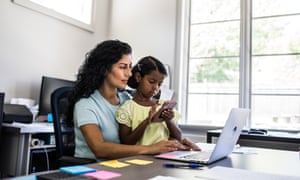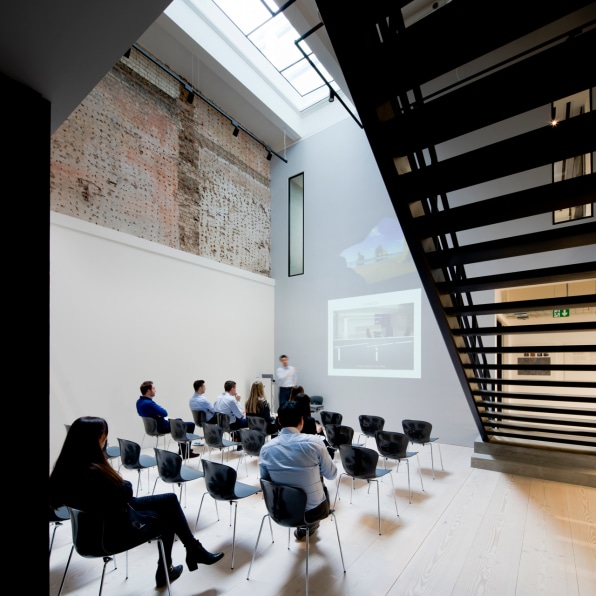
Women and working from home - How do we do it now?
Jan 07, 2021Women and Working From Home In The New Normal!?
As we start to emerge from last few months, it’s becoming clear that the real burden of childcare, homeschooling, feeding the family AND working from home has fallen - on women. Nothing new there then.
BUT there may be an upside…
It has highlighted to all concerned - partners, colleagues, friends - the pressure on women to take on everything. And it’s allowed many women, perhaps for the first time, to delegate to their partners.
Sharing a home and workspace with a partner has been a real eye opener for many couples. In order for both partners to work from home a new division of labour and responsibilities - for example childcare - has had to be drawn up.
For many this has also highlighted the stresses and strains of the relationship, not everyone may be happy with a new way of doing things, it can a tricky and testing time, adding to the pressure.
It has also, for many women, defined what matters most - spending more time at home or needing to get the hell out of there each day.
7 Life Tips From Tina Fey and Amy Poehler
Pay attention y'all
Coronavirus is giving us a glimpse of the future of work – and it's a nightmare
Wasn’t it charming when, in 2017, Prof Robert Kelly was giving an interview to the BBC on the shifting relationship between North and South Korea, and his marvellous daughter stomped in followed by his baby in a walker, and then his stressed-out wife dragged the kids out of the way?
We loved the way he tried to keep his composure in the storm of domestic chaos. That glimpse of home life: the serious man with his geopolitical analysis and the swagger of his little girl who couldn’t care less … who didn’t relate to that?
In work mode, children don’t figure. And now that so many work from home, children must be somehow removed. Women report that, when making Zoom calls, the sight of a child will make them look unprofessional, whereas men fear this less because it makes them look rounded and human. At a certain level of corporate success, this may be so, but for most people the reality of work from home is fraught and muddled.
As the pandemic has made visible every inequality, it has also shone a light on the domestic front. Women at home are doing more. More childcare. More home-schooling. More domestic labour. Even if they are working. The old work-life balance, never achieved in the first place, is now even more severely out of whack. Balance? It’s walking a tightrope of competing needs. Virtual work has no knockoff time: email, WhatsApp and the dreaded, supposedly upbeat, Zoom meetings mean workers are available all the time.
 i
i
‘Women report that, when making Zoom calls, the sight of a child will make them look unprofessional.’ Photograph: MoMo Productions/Getty Images
This inflexibility is then somehow sold as flexibility, but it assumes the worker is always primed for contact. The remote worker is, for some companies, the ideal worker. They don’t need a desk or expensive office space. They don’t need a union. They are malleable and compliant at a time when we are all concerned with the job losses to come. They may not be quite as productive, but they are doing enough to make many big companies think this is the future.
This future can sound bright. No more commuting. Everyone can go and live in the countryside, which we have apparently all hankered for during lockdown. We quit the city and can then afford home offices. How very free. Only none of it quite delivers. Most people who talk this talk already have a spare room in their houses. Most of them earn enough and most of them chose self-employment rather than having it foisted upon them.
What we do need is to rethink how we work, and the answer cannot be an atomised and depressed workforce.
People like to see each other. In real life. If anything, this situation reminded us that there is something about human contact, even eye contact, that no tech can yet produce. Spontaneity and laughter is missing from stilted digital events. Whenever you ask folk about where they got their career breaks or great ideas, it is nearly always from chance encounters; a snatched conversation on the way to lunch or being asked to step in when someone else was too busy. But how are young people, who already can’t afford city rents, to work in their cramped flats? When do they get the opportunity to fly, to improvise, to step up to the plate in informal ways? Face-to-face interaction matters. Serendipity is the mother of creation.
Certainly, the daft presenteeism and the ending of the standard nine-to-five – an anachronism from the days of factory work – can go. And hopefully a lot of management shibboleths, which have been farcical for decades, will recede, too. One is meetings of enormous numbers of people. When I am king of the world, no meeting will be longer than 10 minutes and, no, not everyone will get to speak.
We all know this is a false democracy. In my entire career, the only long meeting I ever attended that needed hours was a case conference to decide the future of a child in care, back when I was a residential social worker. The rest have been displays of ego and territorial pissing. The same goes for brainstorming, another redundant exercise. Brainstorming is just showtime for extroverts. Everyone else sits there waiting for it to be over. Ideas happen when you are not forcing them. Who doesn’t know that?
For too many, work is not purposeful, and lockdown has brought that home, literally – but people need incomes. Those at the bottom of the heap on zero-hours contracts already know that flexibility is a one-way street. Marx talked of four kinds of alienation of labour, and the fourth is when the worker is alienated from other workers. Work is simply an economic practice, and the social elements of production go unrecognised. The great yearning you hear from many now working from home is just this – the social aspect.
A post-Covid-19 future must not underestimate the importance of this to economic recovery. The social part is what makes work bearable for many. For the lucky few, work-life balance feels better than it ever was, but for many, I would wager, we are far from that. Everything is work, and life feels baggy and shapeless. There is no break, there is no off-switch, there is no childcare. Instead, we are meant to do it all – all the time. If this is the future, no wonder so many women I know can’t wait to get back to work – just so that they might actually have a moment to themselves.
Suzanne Moore is a Guardian journalist
_________________________________________________________________
Women in jobs have healthier babies than homemakers - study

Women who were unemployed or homemakers had higher incidences of low birth weight and size, and their babies were more likely to be admitted to the neonatal unit, than women in paid employment, according to the study of over 62,000 Irish women.
In addition, women who were homemakers had an increased incidence of neonatal death, while among unemployed women the rate of stillbirth was higher, compared to women in paid work.
The unemployed and homemaker cohorts were less likely to plan their pregnancy and to take folic acid before conception, and more likely to continue smoking and use illicit drugs during pregnancy, the researchers from UCD and the Coombe Women and Infants University Hospital found.
Observational study
Even after adjusting for continued adverse lifestyle behaviours during pregnancy, the association with adverse outcomes persisted.
The observational study was based on the outcomes for more than 62,000 women who gave birth at the Coombe between 2010 and 2017. One of the largest maternity hospitals in Europe, the Coombe sees a diverse mix of patients in terms of socio-economic background.
The authors say their study challenges previous results and assumptions that homemakers provide the best scenario for desired foetal development.
“In some cases, such as those working in factories, mining and construction this may be true, however we found that when comparing women in paid employment as a whole to homemakers, these women had not only improved pregnancy outcomes but also improved lifestyle and pregnancy-related behaviours.”
Maternal employment
While the link between unemployment and poorer pregnancy outcomes is well-established, the Irish research sheds new light on outcomes for homemaker women.
“It does suggest that, depending on the type, work can be good for you, in terms of pregnancy outcomes,” says Prof Michael Turner of UCD’s Centre for Human Reproduction. “It brings in income to provide for you and your family; you eat better, exercise more and may be able to employ carers for other children.”
However, he acknowledges the homemaker group is a diverse one that includes women who were on social welfare benefits before their pregnancy and women who are well-supported financially and who consciously chose to stop working before having children.
A possible weakness of the study is that information on employment status from women is self-reported, the authors acknowledge.
_________________________________________________________________
A work life balance doesn't exist
Companies are rushing to reopen their offices. Here’s what they’re getting wrong
Flexible work is here to stay. Where we get our work done is less important than how we get our work done.

The coronavirus pandemic forced many of us to work from home, and the big surprise is: Work got done. Employees are still productive. They like the freedom of remote work. Yet some organisations are scrambling to reopen their offices as quickly as possible, and to do so, they are trotting out design solutions that supposedly protect workers, from algorithms for re-densifying offices to clinical “scrub” rooms in reception areas to the sorts of cubicles made infamous by Dilbert and “The Office.” One problem: These strategies are reactionary and irrelevant long-term. To cultivate the office of the future, companies need to acknowledge three truths about the modern workplace that existed even before COVID-19:
2. For offices to be effective, people have to want to work in them.
3. There is no “getting back” to normal.
We are at a crossroads. We can fall prey to panic-driven decision-making, or we can work to become resilient and flexible. Here’s how to better align tomorrow’s offices with how people actually work.
Put the well-being above all else when making workplace design decisions.
Open offices have made it easier for companies to squeeze more workers into smaller spaces, reducing real estate overhead costs. Workers have complained about these designs for years: They’re loud, they’re distracting, and there’s no privacy. Now they’re also a health hazard.

Talent is the most important asset to many organizations; it makes up their largest financial investment. So it’s only logical that workplace design would prioritize workers’ health and well-being. Emergency departments, the workplaces of front-line caregivers, offer an intriguing case study. In some hospitals, sensory booths are being inserted into underused spaces so that staff can decompress. There has been new investment in materials, such as flooring, that cost more yet decrease noise to reduce stress for employees and patients alike.
2. Invest in workplace research—especially when it leads to hard truths—and build upon the findings.
Work happens away from the office now because it must. The National Bureau of Economic Research estimates that 37% of all U.S. jobs can be done from home, which represents 46% of all wages. Pre-COVID-19, only 5% of jobs were done from home. So, the question is: Once we feel it is safe enough to have a choice, where will we opt to work?
The data exposes an uncomfortable truth: Any hurried rush to “get back to the office” misses the point that the reason we go to the office has changed. Working remotely has quantifiable benefits, and they’re not going away. We are interior designers at a large architecture firm, and our own internal research has revealed to us that employees believe working from home has helped them work smarter, faster and more productively. Findings such as these need to inform the next iteration of the workplace.

3. Embrace flexible work policies, and design workplaces that reinforce them.
Because flexible work is here to stay, where we get our work done is less important than how we get our work done. Flexible work policies put talent wellness and productivity first. They bridge the gap between how we do the work we need to do, and what the workplace needs to do. This is a design problem, yet our physical environment is only one piece of the solution. We must adopt a systemic solution.
Once you’ve figured out how your teams work—and how they want to work—you can start to think about what purpose a physical office might serve. And that might differ from one office location to the next. Before COVID-19, employees in our Chicago office wanted more access to nature, so we incorporated biophilic materials and started a plant program that includes edible herbs. Our employees in London wanted to feel more connected to the community, so we prioritized space to host art fairs, panels, and design events.
Now that we are in the throes of a pandemic, those priorities will no doubt change. The key is to have a process in place that allows the contemporary office to adapt. How will we remain resilient while fostering environments that make work enjoyable, meaningful, and valuable? By acknowledging truths we’ve long ignored and investing in work environments that put people first.
Elizabeth Fallon and Kate Davis are interior designers at HKS, a global design firm.
How to turn the overwhelm lights down low
If you know anyone who might enjoy these blog posts please forward this to them now, thank you very much X LA
What do you need? Motivation and support? A bit of a kick to get you going?
Stay connected with news and updates!
Join our mailing list to receive the latest news and updates from our team.
Don't worry, your information will not be shared.
We hate SPAM. We will never sell your information, for any reason.


